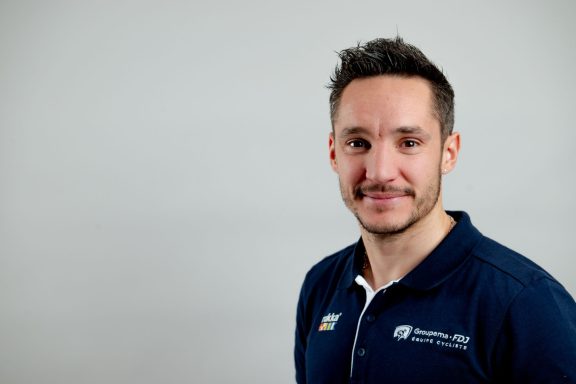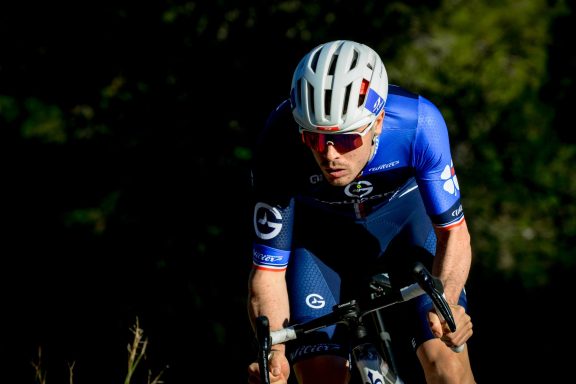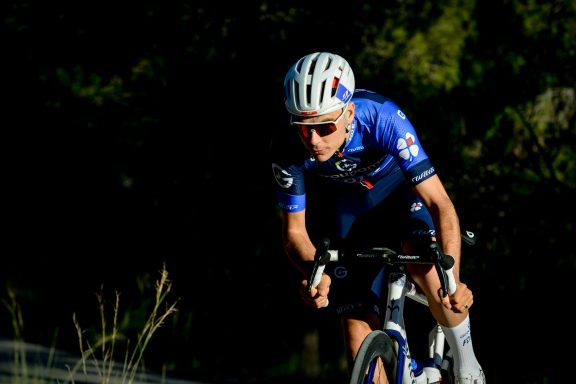A new chapter opened in 2024 for the Groupama-FDJ cycling team, with the arrival of a brand-new cycle partner: Wilier Triestina. The century-old Italian brand, based in Veneto, is aware of the many challenges that come with this partnership. In this interview, the company’s CEO and sales director Enrico Gastaldello first introduces the brand and talks about the sponsorship’s motivations and ambitions.
Enrico, can you give us a little history of the Wilier Triestina brand?
The Wilier company was founded in 1906 in Bassano del Grappa by an entrepreneur named Pietro Dal Molin. He started producing bicycles, and from the information we collected, the company also provided means of transport to the army during the First World War. Bassano del Grappa is a small town located ten kilometres from Rossano Veneto, where the headquarters are now, where I was born, where I grew up, and where my grandfather and my father worked before me and my brothers. Just after World War II, Wilier began to sponsor a professional cycling team. From 1946, the brand had its “factory team” at the Giro. In a way, Wilier contributed to cycling’s revival and popularity in the post-war period. In Italy, we were obviously very passionate about this sport due to the Coppi-Bartali rivalry. In the Wilier team, there was the third “man” of Italian cycling: Fiorenzo Magni. He was also very popular because he tried to make a room for himself between the two campionissimi, and also achieved great victories like Giro d’Italia in 1948 and Tour of Flanders in 1949 and 1950. At that time, the brand built its history and a great reputation.
“A first approach to team sponsorship in the 80s”
What is the origin of the brand’s name and logo?
Wilier is the acronym for “W l’Italia liberata e redenta” (Long live Italy, liberated and redeemed). Our symbol is now the halberd of Trieste, but if we look at the older symbols of the brand, we’ll find the banner of Bassano del Grappa in addition to the halberd. The origin of the latter comes from the 1946 Giro d’Italia, which the Wilier team participated in. The 12th stage supposed to end in Trieste was stopped due to a political protest. At that time, the territory of Trieste was a “neutral zone”, controlled by the English and American armies. The city was divided in two, just like Berlin. There were left-wing political forces, close to communism, and remnants of fascist forces. In the 1946 Giro, these political issues led to the race being blocked fifteen kilometers from Trieste. A “trick” was found eventually to let part of the peloton enter in Trieste, led by the captain of Wilier, a rider from Trieste called Giordano Cottur, win. This victory brought a lot of joy to the city and calmed the spirits a bit. This is one of the reasons why the founder of Wilier decided to associate the name Triestina (meaning “from Trieste”) with his brand.
How did your family happen to be in charge of the brand?
In the 1950s, the “economic boom” arrived in Italy. The company entered a financial crisis for some reasons, including the decline of the bicycle industry. Wilier closed in 1958, and years later the court handling the company’s bankruptcy put ownership of the brand up for auction. At the time, my grandfather owned a cycle shop in Rossano Veneto, where he did repairs and made a few bicycles of his private brand. He jumped on the offer and won the auction. The Gastaldello family became the owner of the brand in 1969. For a few years the company remained quite small, with sales limited to the province and the region. They did not export, but continued to manufacture the brand’s typical product, with the “copper chrome colour” of the Wilier bike. Then the company continued to grow. In the 80s, my father made a first approach to team sponsorship with Mecap-Hoonved, followed by several years of partnership with other teams. During the 80s and 90s, we were able to achieve some good results, including an Italian championship. At the end of the 90s, the third generation came: me and my brothers Andrea and Michele. We decided to enter the business more seriously, even though we went to the store to help my grandfather, my father, and my uncle every summer growing up. We always liked it, even if we were more footballers (smiles). We enjoyed dealing with customers, making a few sales, following up with a few customers, and we would also make deliveries by van in the region. We would leave at 5 a.m. with an employee and it felt like small trips. It was a whole different time.
“After the 1997 Tour, the international market really opened for the brand”
Under your leadership, the brand also returned to professional cycling.
Indeed. We developed the company, then in 1995, we wanted to sponsor professional teams again because we loved this sport and we wanted to try this adventure. We first reached an agreement with the Brescialat team, then in 1997 we got a dream opportunity with the Mercatone Uno team. They took a gamble by signing Marco Pantani and created a great team around him. Unfortunately, he abandoned the Giro after a black cat crossed the road. That day, I cried in front of the TV. He recovered for the Tour, where he got better and better every day, and in the first alpine stage to the Alpe d’Huez, he wrote his name in history as he set the current climb’s record with a Wilier Triestina bike. Two days later, he won again in Morzine and secured his final podium. Following this sponsorship, we continued our sales in Italy, but we also started to export a little to neighbouring countries such as Austria, Germany, and Slovenia. Distributors also started calling me from the United States, Japan, Spain, and the international market really opened for the brand. Unfortunately, we were still a small company, and we only had a one-year contract with Mercatone Uno. Bianchi, which was much bigger, took over sponsorship the following year and Pantani did the Giro-Tour double in 1998… We then resumed a sponsorship cycle with Brescialat, which became Liquigas, then Gerolsteiner, Cofidis, Lampre, with whom we have also built a great prize list. It was also the opportunity for us to invest in a new headquarters and new products, particularly off-road. Later, with the reform of the WorldTour, we went back to the pro continental level, and we tried to develop an Italian team for three years: Wilier Triestina-Selle Italia. Then, we wanted to get back to the top and return to the WorldTour. This opportunity came in 2010 with Astana.
Which bikes have left their mark in the company’s history?
In addition to that of Marco Pantani, one of the cornerstones of our production was the Cento1 model, which was launched in 2008 and pushed by the victory of Alessandro Ballan at the World Championship in Varese. It is the first model that was thought out and designed by us from start to finish. We invested and believed in this project, and it was an important model for us. This started our journey of going deeper into aesthetics, performance, weight and materials. Another very important model was the Cento10, in 2017, which Filippo Pozzato was among the first one to use. We were the first to integrate the cables into the handlebars. I remember a photo where, during one of his first races, Pippo shows the bike to Cancellara who remains speechless. It was a nice innovation. Then the Zero SLR, introduced in 2019 with Team Total Direct Energies, was also a great and successful product, which allowed us to gain even more recognition from the public, the professional peloton but also from other competitors.
“It seemed to be the perfect match”
What is Wilier Triestina’s strength?
Our objective is to make products that satisfy the public and push them to achieve new goals. We want to provide an aesthetic product, comfortable and that performs well, which makes possible the greatest success for the teams we collaborate with. We showed that we could win and obtain these very important results with our bikes. Apart from that, as an Italian brand we want to offer an experience and an attention to details, like modern artisans, that might be a little different compared to big brands. I like to say that we are the new generation of the best italian cycling manufacturing. Wilier’s strength is to offer state of the art bicycles. We have history, we have passion and a big aim to innovate. Even more customers want to share their passion with a company like ours.
Why did you want to start a collaboration with the Groupama-FDJ cycling team?
We were looking for a top team. A team with tradition, history but also a high-performance one. We wanted to negotiate with a team taking into account its UCI ranking, prospects, and interest in young talent riders. Just like us, who are not part of the market’s giants, Groupama-FDJ may not today have the same budget of the top-3 teams and must take a path similar to ours: investment. While we must invest in innovation, they must invest in youth, discover talents, and help them develop. It seemed to us to be the perfect match for the characteristics of our brand. For Wilier Triestina, it is the right team at the right time, in terms of our ambitions and our position. From the start, it seemed like a natural partnership.
Does starting a partnership such as this have any major challenges?
Getting started is always the most difficult part because riders are used to a certain product and have to change it. The teams are important to us, their needs as well, and we must be able to organize supplies within decent timings. The initial phase is therefore the most critical one. That said, once the process started and after getting to know each other well, we did not face any major trouble. Of course, there are always challenges as it is our responsibility to satisfy specific requests in the shortest possible time, but I feel that the partnership is off to a good start. When there is change, there is enthusiasm at first too. You have to live up to this enthusiasm and not make mistakes. We feel the responsibility, and for the company, sponsorship is crucial. We respected the timings, and the riders are happy. After the December delivery, we received only positive feedback from them. We felt real enthusiasm for the Filante SLR Road Bike and the Turbine SLR time trial bike, and that made us very proud. We knew that the challenge was all the more important because we had to take over from a good brand which had been working with the team for many years and contributed to many successes. It wasn’t easy, but we are on the right path. I also see this with regard to the public who have started to notice the Groupama-FDJ product. We have good order figures for it.
“If we do our part at the production level, the team will also do its part on the field”
Precisely, what was the inspiration for designing the Groupama-FDJ’s Filante SLR?
We came up with some ideas taking inspiration from some Italian fashion brands. Like shoes with a slightly old-fashioned colour and shades that give a worn look to it. I personally suggested something like this with a shading reminiscent of the team’s colours. Also our marketing team analysed the current colours in the World Tour, we realized that the white was rarely used, and we thought that this would make it possible to clearly make the team stand out. Finally, Groupama-FDJ also had its part, indicating the weight of the paintwork as an important aspect to consider, so much so that in the end our road bike was among the top-three lightest of the entire World Tour circuit at the Tour Down Under. In short, all these points led to the creation of the current delivery of the Filante SLR x Groupama-FDJ.
What do you expect from the collaboration with the team?
We hope for a fruitful collaboration, which will allow us to further improve our products and raise up the brand. We are also in the process of finalizing some important projects. Some novelties will be introduced during the season. The respective R&D departments are working throughout, and we expect some news between the Critérium du Dauphiné and the Tour de Suisse. Then, as the Tour de France starts from Italy this year, it is an exceptional showcase to raise awareness of Wilier Triestina together with the support of the team. From a marketing point of view, we expect a collaboration that will allow us to create appropriate content and grow on digital platforms. The objective is twofold: to strengthen Wilier Triestina in terms of innovation – and we are convinced that this can also be real added value for the team -, then to rely on the team to develop communication projects and activities, on the ground, which allow us to build solid marketing. Finally, we totally share the team’s goal, which is to go to races to win, not just to participate. We are convinced that if we do our part at the production level, the team will also do its part on the field.
There is also a common interest in Research & Development.
It was even one of the first conditions to start the partnership. Whether for us or the team, we were looking for a partner to be able to grow from an R&D point of view. For us, it is important to have a team that pushes us to always do better, and on the other hand, it was important for the team to have a company capable of meeting its needs. As soon as the agreement was finalized, we started to develop some new exciting projects. The team is in contact with our headquarter every day to improve all the aspects regarding the bicycles. From this point of view, everyone is completely satisfied. The collaboration with Groupama-FDJ pushes us to continue our journey of innovation and development, and to offer the best possible products, both for athletes and consumers.
“We hope the team will be able to do great things in the Giro and the Tour”
Have you already spoken with Stefan Küng, who has always been very involved in equipment development?
We met Stefan in Calpe when we were invited to the training camp. I felt that he was pleasantly surprised that we, the owners of the company, were there to talk and exchange with them in order to improve their performance. This is an added value that we have compared to other major brands. I saw that this was important for Stefan to be able to speak directly with the owners, make his requests, and see that he has people in front of him who provide answers within a decent timing. It also convinces the athlete that the product was developed as requested. Generally speaking, the team really likes the fact that decisions are quick and concrete. Obviously, we can’t promise everything, because some things take more time, but if we are honest and show that we’re fully committed, this added value can make a difference. On the other hand, it is also up to us to welcome Stefan’s expertise as it should be. This is part of our growth, there is always room for improvement.
What would be a good first year of partnership for you?
We would already be very satisfied if the team could keep its current position at world level and repeat the results achieved last year, with good exposure in the Northern Classics, where we have good markets. Then, we hope that they will be able to do great things in the Giro and the Tour and bring joy to the fans. The only thing I’m a bit sad about is not having Thibaut Pinot anymore. Having him in the team and our bicycles would be something special. For us, it’s a bit of a pity that he didn’t continue for another year (laughs), but when I look at the team I see many talented riders, some who I’m convinced will give great joy right away and others I hope will do so in the coming years. The start of the season actually proved it. We hope it continues like this.



No comment